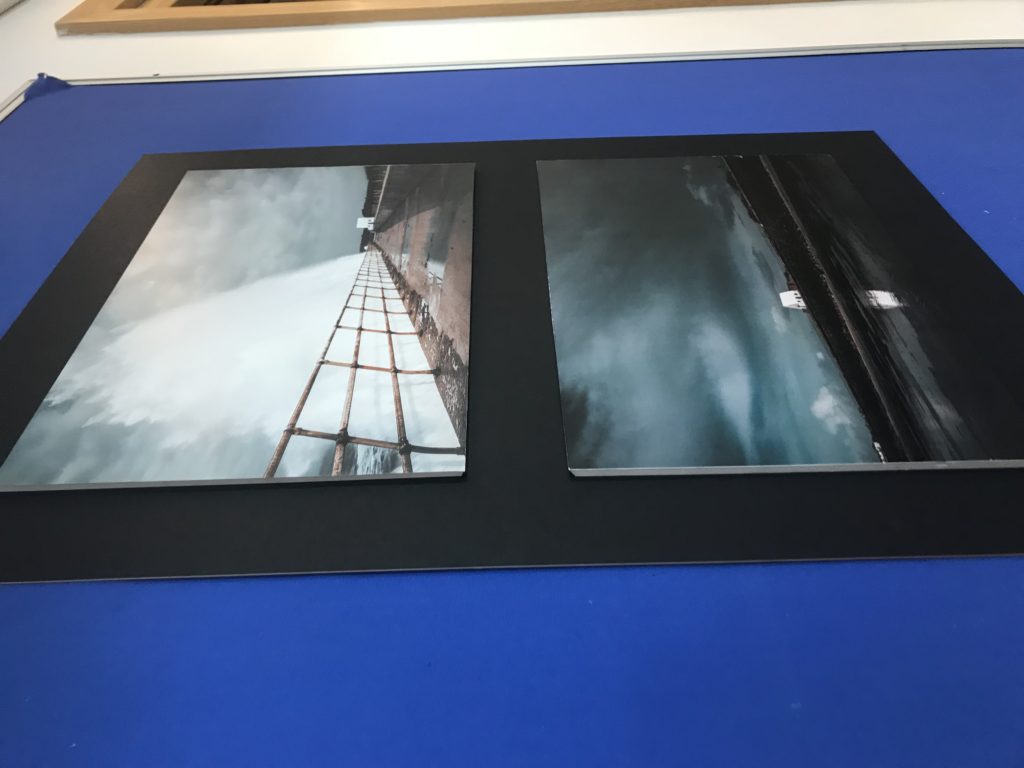below is the link to my final photobook
All posts by Thomas Webster
Filters
FINAL IMAGE PRESENTATION
During my exam day three, I mounted up all of my printed images onto black/white card and foam board to make several separate installations of photography to go alongside my photobook.
I had printed out my best images that were incorperated within my book with the intent to create a series of mini stories presented in diptychs and triptychs. This would allow me to create many more narratives alongside my main narrative contained inside my book. I had pre-arranged a layout that I would follow for each board in my previous lessons before the printed images came down.
The images below show the four concepts that i came up with. They are all arranged differently depending on the types of images used, the sizes of the image and what works best to allow them to fit together.
It is good to have both a physical version of the book with all my best images from the shoots I have produced as well as these four boards. Having the physical prints on a large scale, especially shown in the A3 images is very rewarding because it allows me to see my imagery on a large scale and as a series that, personally, I think has worked well. It has allowed me to construct further narratives and stories that otherwise would not have been displayed through my photobook. I used two methods to present my work seen above, one being framing and one using foam board to lift the images out to appear 3D. I think the mounted images have worked better as they reveal a cleaner and more professional look however the foam board images have allowed my landscapes to really stand out, especially the ones on the black board as it compliments the moody skies.
FINAL BOOK LAYOUT



To introduce my book I wanted to make it clear to the audience this sense of change which is the ongoing theme within my book. This set of images on the opening page show these ideas of variation through the difference in water level, one being at low tide and the other at high tide. Another main focus within my book is the variation of lighting within the same location which is evident in this spread as one image was taken at midday and one at sunset.

I chose to opt for a double page spread for this image due to the fear of the unknown it creates. The thick clouds and fog obscure the horizon creating a sense of isolation in the way that the clouds appear to be closing in on us. Also it represents an expression of time exposed which act as a time capsule for a series of events in time. This is effective at the start of my book in showing how the whole book is about the events within a day of changing weather, lighting and sea.



I felt as if the above image is very strong in aesthetics and therefore believed it would work best as a double page spread. I ensured there was no boarder to emphasize the sense of isolation and really engage the viewer, making them feel as if they are there. It feels moodier and slower than in reality which i deliberately constructed to show the power of nature and emotions it can evoke.


I think that this method of presenting my work, implies the passage of time and timelessness, echoing the oceans perpetual cycle of change and renewal. By using this triptych method, it allows the viewer to see beauty in each individual part of the landscape as appose to when it is as one photograph.


I thought that this image worked really well within my photo book, mainly to give the viewer a break from the main structure of the book. It allows the viewer to really engage with the beauty of the ocean. The depth within this image has signification of a journey, representing the cycle that the ocean undergoes everyday and also mimicking the journey that the viewer is on within my book.




I like how the above two pages lack the physical detail with an absence of a main focal point, any land mass and objects. Instead strongly focuses on the lighting and textures which are often not appreciated within the landscape. This was inspired by my studies on metaphysics. Through these two pages there are underlying messages about what exists past our reality for example underneath the sea. Also connections to what we may not be able to see in our reality such as the changing light as it happens which is portrayed through the typology.


The diptych above was specifically chosen as a result of the similar patterns within the plants and the ocean froth. I think this similarity in textures and shapes is really interesting, especially due to them both being natural yet different things. This evokes a relationship between these two elements of nature which stimulates a sense of beauty. Also the juxtaposition between the golden light on the left image and dull moody tones in the right image compliment each other.


This is one of my favorite photos within the photo book, hence why I chose to give it a double page spread. I was really pleased with the composition of this photograph, highlighting elements of beauty (the flowers) contrasted with feelings of intimidation and threat (the clouds). I like how the flowers lead the viewer to the to the cloud formations whilst also mimicking the shapes of clouds with the textures they contain themselves.



Gaining inspiration from the constant and seamless cycle of matter, from air to water to cloud and vapor, and back again i captured this photo that represents this with the intense cloud formations.

I specifically chose these images to end my photo-book with as it represents the end of the journey that the weather, lighting and ocean has undertaken throughout my time photographing it for this project. The photograph on the right is the view that is seen when you reach the bottom of the stairs that can be seen on the left. I think that a sunset image works well due to the fact it portrays the end of the day, highlighting that it is the end of my book. The image of the stairs symbolize a sense of movement and time that occurs to result in the changing weather conditions and sea change.
Constructing diptych and triptych (Nadav Kander inspired)
As well as being great story-telling devices, diptychs, triptychs are visually pleasing and help make use of photos that may not work on their own or perhaps enhances a single image with the method. There is no right or wrong when it comes to these composites so my main aim was to use the method with single images as appose to using multiple images. This idea was inspired by Nadav Kander’s work that I have previously looked at. I am inspired by this method and think it enhances the viewers appreciation for the image due to the fact it is constructed into two or three separate images instead of only one.


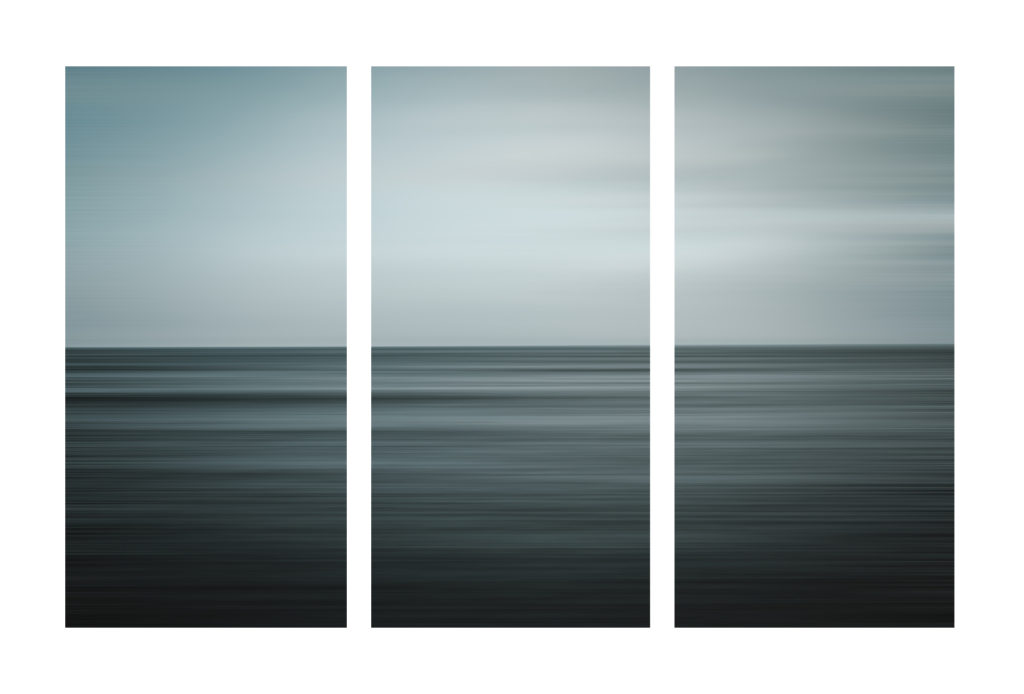





I think that this method of presenting my work, implies the passage of time and timelessness, echoing the oceans perpetual cycle of change and renewal. This idea also reflects how the view we are looking at has been experienced by many of our ancestors despite the change in time period. This shows a sense of underlying beauty in what otherwise would be a rather boring landscape, linking to my studies on zen Buddhism. The notion of time created emphasizes how the landscape is always changing and brings a focus to the external factors that i have tried to portray in this project such as lighting and weather change.
Book title choice
For my book, I have decided to entitle it ‘Moonscape’. Due to the content matter and what I am presenting to my audience through my photographs, I feel it is quite a suitable title and a title that has meaning. Despite my images aren’t actually of moonscapes, it will bring surprise to the audience which will stimulate thought processing of how the moon affects tidal movement. The main idea behind titling it this is because I don’t want to give away the content matter through the front cover. Also it has significant meaning with the scientific way in which the moon effects the ocean movement which is a key idea within my project.
Official definition of the word : a landscape resembling the surface of the moon, especially in being rocky and barren.
Wikipedia explanation – A moonscape is an area or vista of the lunar landscape, or a visual representation of this, such as in a painting. The term “moonscape” is also sometimes used metaphorically for an area devastated or flattened by war, often by shelling.
Scientific explanation :
While both the Moon and the Sun influence the ocean tides, the Moon plays the biggest role because it is so much closer to our planet than the Sun. In fact, the tidal effect of the Moon on Earth is more than twice as strong as that of the Sun, even though the Sun’s gravitational pull on Earth is around 178 times stronger than that of the Moon. The gravitational force of the Moon and the Sun pulls the water in the oceans upwards making the oceans bulge, which creates high tide in the areas of Earth facing the Moon and on the opposite side.
At the same time, in other parts of the planet, the ocean water drains away to fill these bulges, creating low tides. However, the oceans’ water is also constrained by the continents and varying ocean depths. As a result, the tides behave more like water sloshing around in an oddly shaped bathtub than in a smooth and even basin.
Nadav Kander – Dark Line – The Thames Estuary
His ongoing series, Dark Line – Thames Estuary, focuses on the point where England’s longest river meets the sea. Arranged in diptych or triptych, the photographs look to obscured, uncertain horizons, evoking a sense of departure, loss and longing. The textured, yet often desolate images present a Thames that is sometimes violent, sometimes still. “I wish to make work that does not literally describe what is in front of me,” says Kander. “I do not wish to focus my lens and capture a millisecond of realistic information.” Throughout Michael Martens ‘sea change’ book he has also used the diptych or triptych method and therefore I will aim to try and complete some to implement into my photo book that i plan to do.
From an interview with Nadav Kander :
Could you describe the project for anyone who hasn’t seen it yet?
NK: Dark Line follows the Thames Estuary, the part of the river where it widens and slows down, where the river reaches the end of its journey and enters the North Sea. I’m very interested in the idea of journey and destiny, which works perfectly with the notion of the river widening, slowing and ultimately ending – and yet is the end really the beginning? To use T.S. Elliot’s quote, ‘In my end is my beginning.’ Does the river end or does it begin? Does it get evaporated and rise up into cloud and rain again, and do the cycles of life just continue onward? Is it not as human beings we’ve become caught up in having a beginning and an end?
I think that these ideas that Kander has described is really thought provoking and allows his images to contain a much deeper meaning than they would have otherwise. This sense of questioning reality and the notion of thinking ‘is this the beginning or end’ really allows a deeper thinking into life and essentially our perspective. This links to the ocean and the way in which we don’t know what lies beneath the surface, creating a sense of unknowing. This was taken of interest by my previous artist Jem Southam and i think it is interesting to see how different artists have explored similar ideas with a similar subject matter yet in different ways. Also Hiroshi Sugimoto displays a similar view presenting a different way of looking at a relatively boring subject matter, thus being the ocean.



The fascinating thing about this series is how unrecognizable the Thames is. It feels moodier and slower than in reality. I think this shows us Kander’s view of how he feels about the world around him and what slow moving, dark water means to him. In an interview he said “I don’t necessarily feel like that every time I’m there photographing but it’s how I feel about it more generally.” Kander elaborates in the interview to say that “there’s a lot of fear of the unknown” suggesting that the sea is the unknown after a bad experience when he was a child. On the other hand, despite the sense is isolation and mystery, Hiroshi Sugimotos project presents us with ideas of feeling a great sense of destiny or even voyage of where it might take them.
I think as a result of looking into this project I want to firstly create a series of diptych and triptych’s with my images that i have already collated. I also will conduct a photo shoot at sea level which will differ from my previous shoots that are often higher up, on top of cliff tops. Within this photo shoot, I will aim to portray a sense of darkness and the unknown by editing them in these ways but also using the weather to my advantage to enhance this.
Golden Hour Shoot (changing light)
To juxtapose with my previous shoot, i returned to the same location to capture a variety of similar images but this time at sunset. Returning at sunset would give me golden lighting that would illuminate the cliffs in a completely different way to my first shoot on a stormy day. I ensured that it was a clear day to allow for the suns rays to create the most interesting colors upon the surroundings and therefore give a direct contrast between the two shoots in this location. I find it really interesting how much impact the lighting and weather have on a location and this is why i keep returning to the same locations at different times and at different days to see how the change in these external factors convey a completely different story/mood.
Contact Sheet



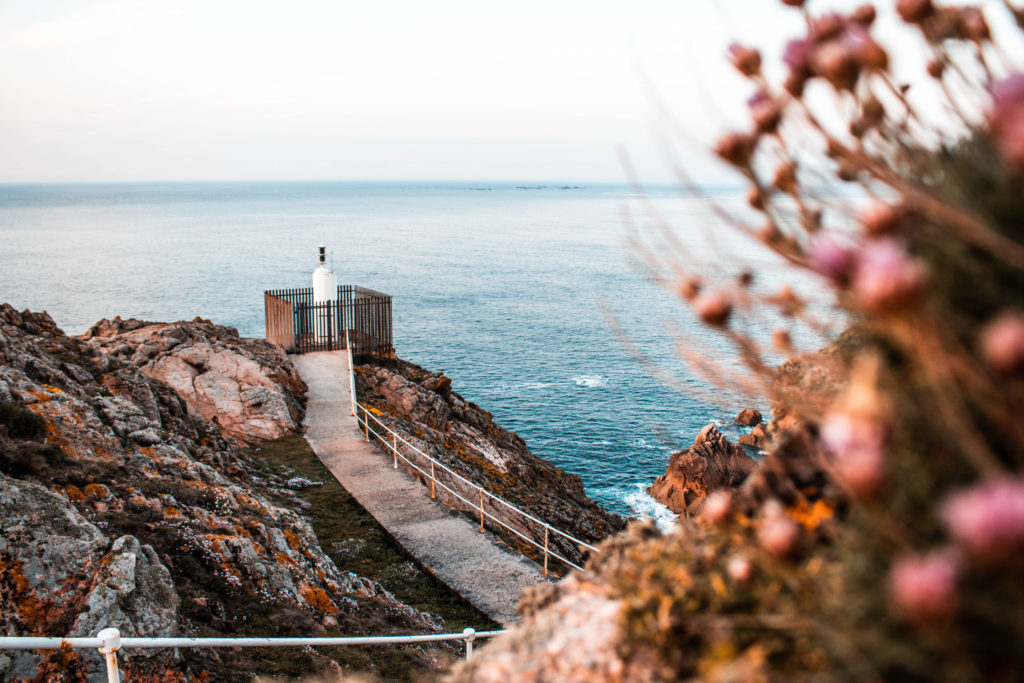














Response to Jem Southam – Moody Weather Shoot
As a response to Southam’s ‘The long cloud’ project I wanted to try and capture a sense of darkness and negative emotions. To achieve this I needed to wait until the weather turned moody with interesting cloud formations that would help to create a sense of isolation and intimidation. As I was on my home from school there was a storm approaching creating very interesting textures within the sky, I grabbed my camera and headed to Gronez to shoot it. The results of my shoot can be seen below.
Contact Sheet

Edits



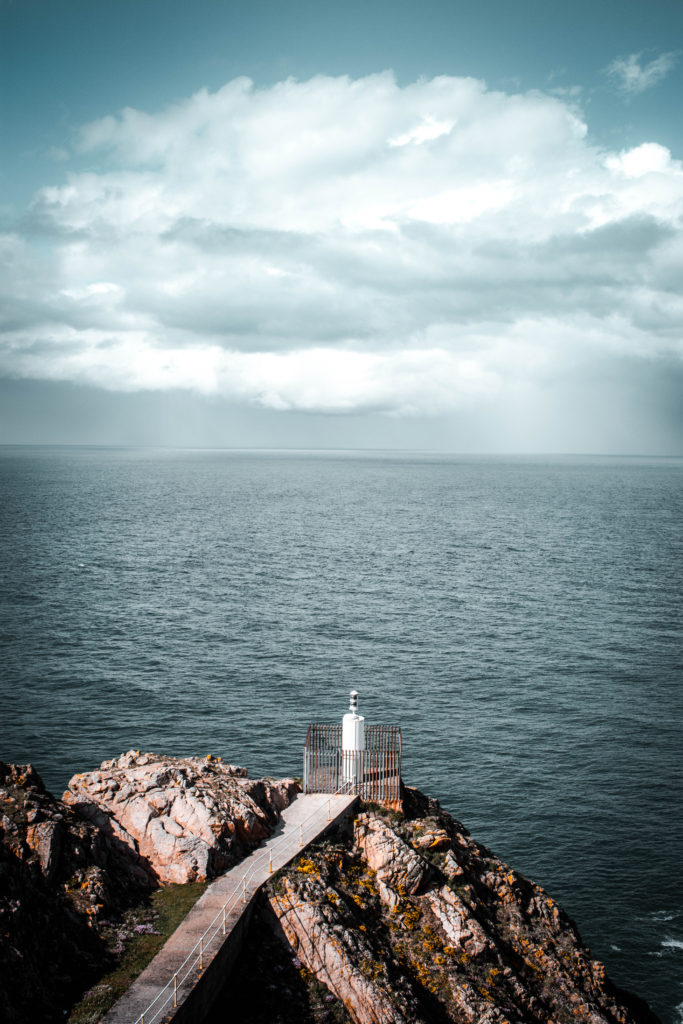

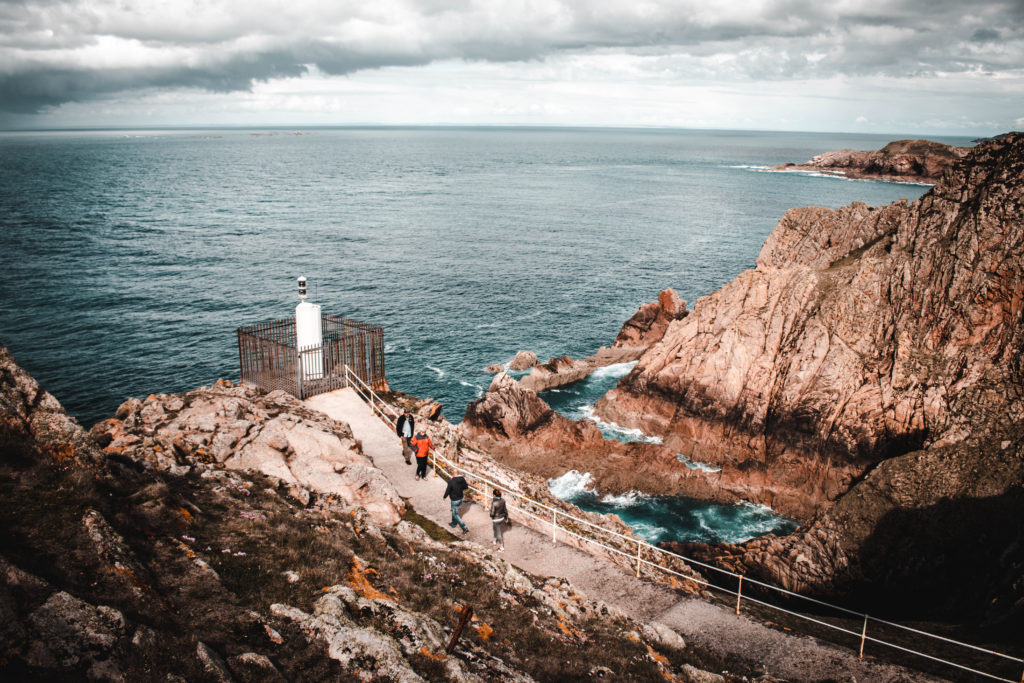







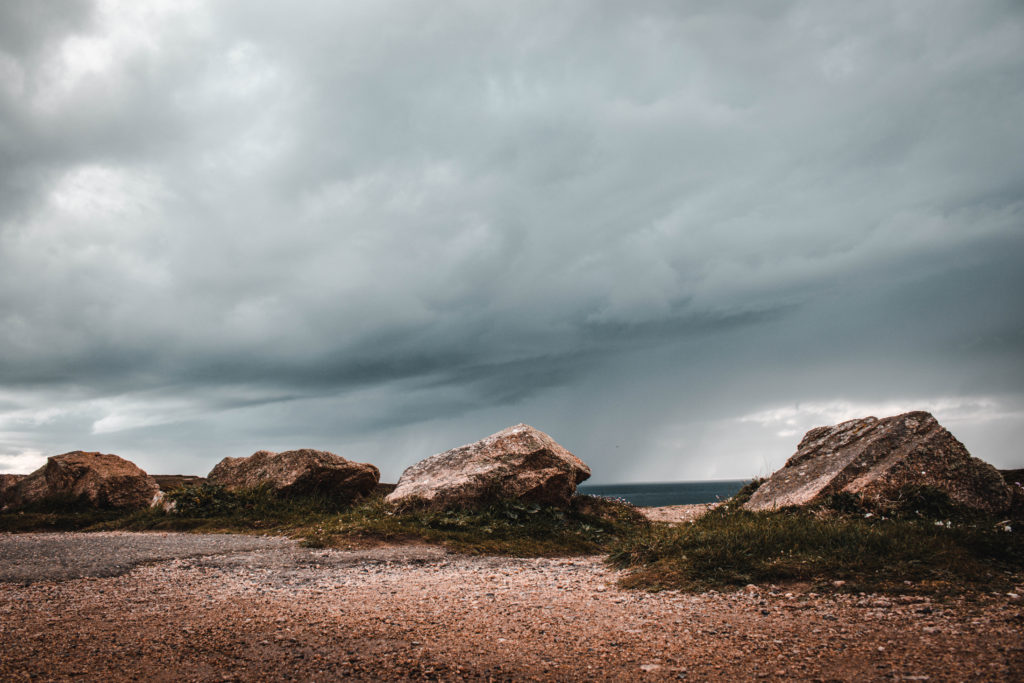
Analysis of the shoot
Overall I was very happy with how this shoot turned out, primarily due to the luck I had with the sky forming such a dramatic clouds. This dramatic feel was enhanced through the editing process which i undertook in light-room, increasing the clarity and contrast and de-saturating most of the colors. I think the images of the cliffs have been successful in creating a sense of isolation and intimidation due to the large scale of them. However, next time I would try to get down near the bottom of the cliffs to give a sense that the cliffs are looking over us creating a much more intense feeling. This would also make the cliffs appear bigger due to the perspective. Within this shoot I think my most successful images are the ones which have flowers in the foreground because it gives the image a great deal of depth that otherwise would have been limited. The foreground also helps to lead the viewer to the specific parts of the images that i wanted to bring attention too. With the absence of any buildings or urban areas means the viewer cannot claim to know the time period at which the photos were taken. This gives a sense of mystery and the unknown which is really interesting as it gets the viewer engaged with the image. These ideas are also portrayed through having the ocean appear in my images because it is not known what lurks beneath it which Southam has quoted interests him about bodies of water. This links back to my original artist study on Hiroshi Sugimoto that has a clear purpose to show this sense that it doesn’t matter what time period the image was taken, the beauty comes from knowing that our ancestors have all experienced the same view.
Jem Southam: The Long White Cloud
Jem Southam, born in Bristol in 1950, is one of the UK’s leading photographers. He is renowned for his series of colour landscape photographs, beginning in the 1970s and continuing until the present. His trademark is the patient observation of changes at a single location over many months or years. I was inspired by this idea as it links to my current work looking at the change of sea, light and weather on one location. However Jem Southam is doing a similar concept just on a much larger scale.
He observes the balance between nature and man’s intervention and traces cycles of decay and renewal. His work combines topographical observation with other references: personal, cultural, political, scientific, literary and psychological. Southam’s subjects are predominately situated in the South West of England where he lives and works. However he completed one project ‘The long white cloud” in New Zealand that took my interest.
Within this project the photographs build and expand on themes that Southam has explored throughout his forty-year career. They show his continued fascination with the subtleties of colour, with reflection and transience, and with the effects of the shifting seasons and weather on the landscape. Southam’s documentary practice present a sociological and physiological investigation into the landscape
Southams project focuses on bodies of water found on the island of New Zealand. The series saw him document the watery landscapes enveloped by a huge variety of atmospheres and conditions. The resulting large-scale photographs document the country’s lakes, rivers and dramatic waterfalls, with Southam gaining inspiration from the constant and seamless cycle of matter, from air to water to cloud and vapour, and back again. Exploring notions of the sublime in the varied natural landscapes of New Zealand, these photographs accentuate the connections between the drama of nature to the inherent mythologies of the land. The clear interest in water through his project connects directly to my previous works that so far have focused on coastal areas.

‘Aeoteroa’, or ‘The Land of the Long White Cloud’, was the name given to the North Island of New Zealand when the Maori navigators first saw signs of the new land in the formations of drawn out strands of cloud spreading across the horizon. It is the dynamic at the heart of this apparition that these pictures aim to explore. The remarkably rich and varied physical profusion of landforms of New Zealand apprehended and made manifest through the momentary shifts of light and the weather. – Jem Southam

The Mouth of the Okarito River and the Tasman Sea, New Zealand, Autumn 2018
I chose to look closer into the work of Jem Southam mainly due to his explortion of the natural world but more importantly the way it is changing through light and weather conditions. I have already explored these elements and having came across this artist it has inspired me to try and capture a sense of horror through darker images. I believe this is a side of landscape photography I haven’t properly explored due to the fact usually landscape photography is about making the landscape look the most beautiful. I think that taking inspiration from Southams project will allow me to create a clear juxtaposition between how the landscape looks in nice golden light compared to the dull de-saturated images that I will create in response to this artist reference.
Photo Analysis

The North Wall of the Fjord, Milford Sound, New Zealand, Autumn 2018
This minimalist image is evident of beauty and a great sense of emotion. The towering cliff creates a sense of isolation and intimidation that is enhanced through the harsh weather conditions. The thick clouds and dark lighting from the weather gives these ideas of anxiety and depression creating an overall moody atmosphere. Southam finds himself both entranced and repelled by bodies of water. “The closer we move towards them, the more a resistance builds in us, a dread almost — ‘How deep is the pool, what might be lurking within it?’ Does anything work on our imaginations as powerfully as the waters of the earth?” These ideas that Southam mentioned in an interview on ‘financial times’ links to the ideas I have previously mentioned in my studies about the water and how it creates a sense of the unknown. Although this image contains very little water, the huge cliff structure leads our eyes to the ocean and makes the viewer aware that it is a main focal point in conveying the story through this image. The slanted horizon is a countertype for the stereotypical landscape shot in which the horizon should be straight. This creates unease for the viewer helping to enhance this mysterious and moody atmosphere.
Low Tide Vs High tide shoot comparison
After having completed the two shoots, one at low tide and one at high tide, I wanted to directly compare the photos taken at the same spot. This allows for an easy understanding of how drastic the tidal movement is on our island. It also shows the force and power of nature which is somewhat scary to consider. This was inspired by Micheal Martens photo book ‘sea change’ which I really enjoyed when looking through it. The locations which i chose to photograph are the most commonly photographed locations in Jersey. I wanted to bring a new way of photographing these areas which would be very different from the stereotypical shots. Despite the many photographers in Jersey, I have never seen any images that contrast this tidal movement.
Comparison of work
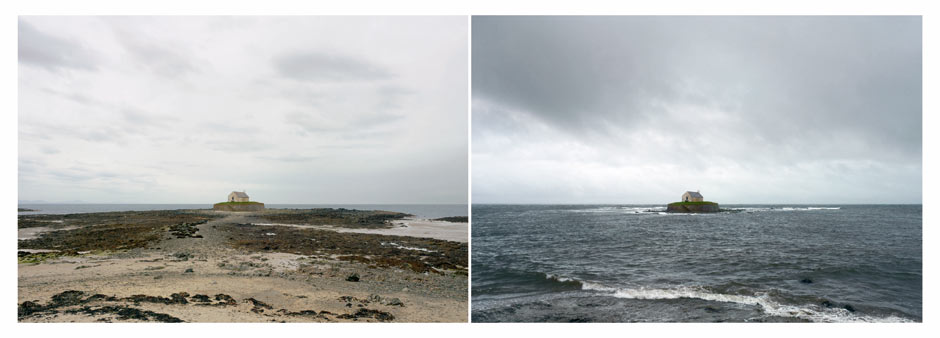
There is a clear similarity within the work that I have produced and Michael Martens too. I ensured that I had a main focal point for the viewer to look at which made the sea change more distinct and easy to see. This is also evident within Martens work where he has a building structure centered in the middle of his image. I took a slightly different route within the composition of my subject. I framed the structure to the right slightly to meet the demands of the rule of thirds which i believe is more aesthetically pleasing. Whilst Marten has a typical one third of sea and two thirds of sky i have opted for half sky and half ocean inspired by Hiroshi Sugimoto. Another difference is the way in which Marten has allowed for similar lighting within the two images where as I have portrayed the changing light throughout the day as well as the changing tide. Thus being reflected through the low tide image being mid day and the high tide image being at sunset.







